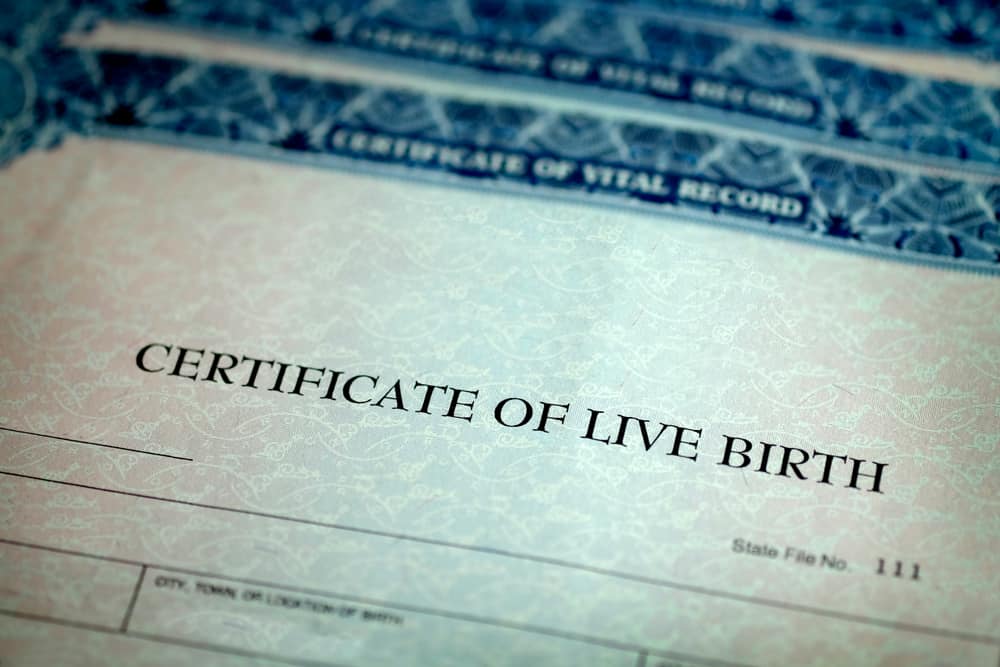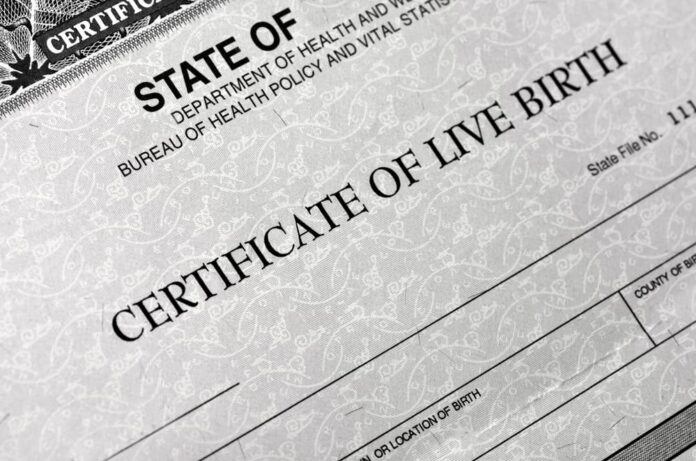There will be many reasons that you’ll need to present your birth certificate.
It’s one of the most important documents that you’ll need to keep safe and legally viable for life.
If you make the wrong decision around the preservation of that document, it could cause some frustrating challenges.
Can You Laminate A Birth Certificate?

No, you shouldn’t laminate your birth certificate if you’re needing it for “official” use.
The birth certificate is a “vital statistic that you’ll need throughout life.
Lamination is irreversible on a paper document.
If you’re only using a birth certificate for research purposes to confirm a birth statistic, as in historical documents, then you can laminate it.
You shouldn’t use any means to repair tears in the paper as this will also render it invalid.
Fraud is rampant with all identification documents, so government and legal offices will reject them.
Why You Shouldn’t Laminate Your Birth Certificate

You aren’t supposed to laminate your birth certificate because there are certain elements on the paper that, upon inspection, prove its authenticity.
When it’s laminated, things like watermarks can’t be seen correctly and official seals can’t be verified.
There are a few things that go into the authentication of an official document.
You can see an example of this in the modern US driver’s license.
They are now hard plastic with several watermarks and prismatic elements that are activated under light.
In the past, they were laminated in plastic and quite easy to replicate.
This caused an issue with counterfeiting, so it was stopped.
The other issue is that lamination will tear and destroy the document upon delamination.
Therefore, if you’ve already laminated the document, it would be counterproductive to try and take the lamination off.
What Are The Alternatives To Laminating Your Birth Certificate?

The reason most people like to laminate documents is that they’re important, and we have to present them to prove birthplace and citizenship.
Replacing them if they’re damaged is a challenge.
What are the alternatives to laminating your birth certificate?
What we’re really asking is, “How do I keep my birth certificate safe?”
It’s simple, and it just takes organization and being cognizant of how you treat sensitive documents.
There are several obvious and not so obvious elements that will harm a document such as liquid, sunlight, and tearing of the paper.
If the agency that’s inspecting the document can’t read everything on it, they won’t bother to try.
They have too many people they have to process.
Alternatives To Laminating Your Birth Certificate Are As Follows

- Purchase an opaque sleeve from a good office supply company online. You can get a pack of them cheaply, and you’ll have them for other documents. The sunlight won’t penetrate the sleeve, and it can be sealed with tape to keep moisture from the humidity that damages paper. You won’t have to worry about spilling your coffee on it either. Tearing won’t happen when you pull it out or transport it once the paper ages 30 years.
- Order certified copies. Go to the department of vital statistics website for your birthplace. Pay for an official certified copy. Photocopies will be rejected. It’s typically inexpensive to get a certified copy. You can place the original in a sleeve and store it in a climate-controlled place if possible. For kids, this is a great idea because their birth certificates are needed so much more frequently than adults in many places.
What Will You Need Your Birth Certificate For?

There are a few reasons an adult may need to present their birth certificate.
With this brief list, you can plan how often you might need it in your own life.
Just keep in mind that these reasons are what’s valid at the time of this writing.
Laws change globally, and you may not know it.
If you move a lot or want to travel or get into a certain career pathway, you may want to check the laws for the place you want to be.
Being forewarned is forearmed in the case of governments and legal agencies.
For some of these things, a social security card (or the equivalent, depending on where you live) is not enough.
It seems counterintuitive because you need a birth certificate or naturalization/citizenship papers to get a social security card in the first place.
Sometimes, it doesn’t make sense, but it’s less of a hassle if you have the birth certificate than if you don’t.
Without it, you will face a lot of bureaucracy and red tape, especially if you laminate your birth certificate or change it in any way.
What Will Require A Birth Certificate

- Applying for a Government Career: You must be a citizen in many places to get a job in the government sector. This is a requirement in the US, and many countries follow suit for many reasons. It’s seen as a privilege of citizenship by birth or naturalization. The higher the office you hold, the more likely you will need a birth certificate.
- Joining the Armed Forces: The military service will allow those who are citizens by naturalization, but those who claim to have been born in the US must have a birth certificate. Other countries have different rules.
- Any Immigration Services: If you are married to or are sponsoring or supporting an immigrant, you must show papers of naturalization or a birth certificate showing you have all the rights and privileges of a US citizen.
- Obtaining a New Passport: For a new US passport, you must show several documents along with an original or certified copy of your birth certificate. For renewals, you must send back the original passport or a birth certificate if you’ve lost the original.
- Marriage: This may vary from state to state and country to country. People can typically get married in a religious ceremony without one. Look into the laws where you are located to make sure that any ceremony is legally binding.
- Access to Social Security Benefits: To receive any benefits in the US, you must show a birth certificate or naturalization papers along with the birth certificate of your sponsor or spouse who is a US citizen.
These are the top reasons for an adult.
For a child, it may be a requirement for starting school along with immunization records.
How To Replace A Birth Certificate

If you’ve jumped the gun and laminated your birth certificate, you’ll need a copy of the original.
We’ve explained that it has to be certified and the seal of authenticity there. Here’s how you replace your birth certificate.
You can do it in a few easy steps.
- Contact the Department of Vital Statistics in the county in the state where you were born.
- Provide them with the information and identification they ask for. Your social security number, birth date, your mother’s maiden name, and your father’s name will be required.
- Pay the fee, which is typically less than $50.
We would also say that it’s just as easy for you to do it all yourself online at the official website rather than pay a company to do it for you.
You could, but you may end up spending more money.
Can I Tape My Birth Certificate?

No, you can’t tape your birth certificate.
Apart from lamination, you may, upon inspection of your birth certificate, decide that it has gotten tattered and torn, and you don’t want it to fall apart in transit.
You may be tempted to break out the Scotch tape, but don’t.
Taping your birth certificate will render your birth certificate unacceptable, and it will be rejected just as if you’d laminated it.
Tape can still indicate a fraudulent birth certificate because those perpetrating such things will attempt to combine two or more birth certificates to create one very fraudulent one with several other people’s vital information on it.
This is not something new. It’s been happening for decades, so this is why there’s so much fuss over a piece of tape.
How To Preserve A Birth Certificate

There are a good many reasons someone may want to preserve a birth certificate.
The first reason may be because you’ll need it throughout life, and you should have it preserved enough not to have to do anything to it that may render it invalid.
One might also want to preserve it for archival reasons.
Some people have birth certificates to authenticate their ancestors.
Here are some dos and don’ts on preserving birth certificates.
Where you store the birth certificate is just as important as what you store it in.
Placing it in a plastic sleeve, as we suggested earlier, is great if you want to keep it safe from dust, dirt, oils, liquids, and potential tears.
However, this is only for the short term.
For the times you may not need to produce the document, which could be years or a decade, then there are more steps to take to ensure the preservation of the birth certificate.
- First, handle it with care. Some of the most eroding elements come from us. Our hands are laced with natural oils. When you do handle it, make sure you haven’t handled any lotions or have any debris on your hands. In fact, wearing gloves would be preferable. As these documents age, the oils they’ve come in contact with will further yellow and erode the tiny, delicate fibers in the paper.
- Make sure you don’t wrinkle or believe it either. Most often, people will fold the document, and this will cause tears along the seam line right in the middle of the paper where you have to read the information. This is the area where most people will attempt to tape it. If it does tear like this, it’s best to keep it folded when you send it off in an envelope.
- Limit the number of people the birth certificate comes in contact with. Make sure they’ve taken care to take precautions before handling. There’s no reason to allow people to handle it anyway. If you’re showing it to family members, then they can view it in a clear plastic sleeve.
- Do not fold it or use paper clips or staples to secure it when you put it away. There are several things you can use for a much better result according to the Smithsonian Institute Archives. A side-loading print sleeve, a 3-ring print page, an archival metal box, acid-free sleeves, and a document storage kit are all ways to preserve your birth certificate.
- Keep the document in a place where you can access it easily. Know where it is in case of a fire. A fireproof box is suggested because you won’t want to go looking for paperwork during an emergency. Fireproof containers can also keep water out. Make sure you don’t store it in a space that can get damp and musty like an attic or basement. Humidity is not a friend of paper.
- Scan and keep a digital copy on a high-quality DVD. Don’t keep a copy on your computer though. If it’s ever hacked, you’ll have a perfect copy out there for replication. Don’t just pick up an inexpensive DVD from an office supply store. Be sure it’s archival quality. It’s best to find something like that online.
- Keep the DVD and any paper copies in a home safe or a safe deposit box. Place them in the protective containers we suggested, and make sure you place those containers in a climate-controlled environment.
- If you decide to display a birth certificate of a relative on the wall, be sure it’s only a copy. If the space you display it in is ever broken into, you’ll have something a criminal can use. Most people wouldn’t give it a second thought, but any personal identification can create a whole new identity for someone else.
NEXT:
Why Is U-Haul So Expensive? (Top 10 Reasons)

